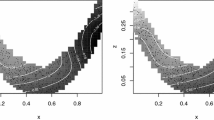Conclusion
The time has come to end our stroll through the Garden ofe-den, even though we have yet to taste many of its most succulent fruits, such as exponential splines [62]. However, I would like to conclude my p-e-an toe in a lighter vein.
Similar content being viewed by others
References
C. C. Gillispie,Biographical Dictionary of Mathematics, Charles Scribner’s Sons, New York, 1991.
W. Dunham,Euler: The Master of Us All, Mathematical Association of America, Washington, DC, 1999.
U. G. Mitchell and M. Strain, The Numbere, Osiris 1 (1936), 476–496.
J. L. Coolidge, The Numbere, American Mathematical Monthly 57(1950), 591–602.
E. Maor,e: The Story of a Number, Princeton University Press, Princeton, NJ, 1994.
A. H. Bell,The Exponential and Hyperbolic Functions and Their Applications, Pitman&Sons, London, 1932.
M. E. J. Gheury de Bray,Exponentials Made Easy, Macmillan & Co., London, 1921.
P. Beckmann,A History of π, Barnes&Noble, New York, 1993.
J. H. Conway and R. H. Guy,The Book of Numbers, Springer Verlag, New York, 1996.
M. Brede, On the Convergence of the Sequence Defining Euler’s Number,Mathematical Intelligencer 27 (2005), 6–7.
H. J. Brothers and J. A. Knox, New Closed-Form Approximations to the Logarithmic Constante, Mathematical Intelligencer 20 (1998), 25–29.
D. Wells,The Penguin Dictionary of Curious and Interesting Numbers, Penguin Books Ltd., Middlesex, England, 1986.
M. Gardner,The Unexpected Hanging and Other Mathematical Diversions, Simon and Schuster, New York, 1969.
H. J. Brothers, Improving the Convergence of Newton’s Series Approximation for e,College Mathematics Journal 35(1) (2004), 34–39.
J. A. Knox and H. J. Brothers, Novel Series-Based Approximations toe, College Mathematics Journal 30(4) (1999), 269–275.
C. D. Olds, The Simple Continued Fraction Expression fore, American Mathematical Monthly 77 (1970), 968–974.
N. Pippenger, An Infinite Product fore, American Mathematical Monthly 87(5) (1980), 391.
X. Gourdon and P. Sebah,The Constant e and Its Computation, http://numbers.computation.free.fr/Constants/E/e.html.
A. Baker,Transcendental Number Theory, Cambridge University Press, Cambridge, 1975.
I. Niven, Which is Larger,e π or πe? in πA Century of Calculus, Part II: 1969–1991, Mathematical Association of America, Washington, DC, 1992, 445–447.
J. M. Borwein and P. B. Borwein,Pi and the AGM, Wiley-Interscience, New York, 1987.
S. R. Finch,Mathematical Constants, Cambridge University Press, Cambridge, 2003.
R. Courant and H. Robbins,What Is Mathematics?, Oxford University Press, New York, 1941.
G. H. Hardy and E. M. Wright,An Introduction to the Theory of Numbers, Third Edition, Oxford University Press, London, 1954.
P. Ribenboim,The New Book of Prime Number Records, Springer, New York, 1996.
S. M. Ruiz, A Result on Prime Numbers,Mathematical Gazette 81 (1997), 269–270.
E.T. Bell,Men of Mathematics, Simon and Schuster, New York, 1965.
H. V. Baravalle, The Number e—The Base of the Natural Logarithms,The Mathematics Teacher 38 (1945), 350–355.
B. Friedman,Lectures on Applications-Oriented Mathematics, Holden-Day, San Francisco, 1969.
G. H. Hardy,Ramanujan, AMS Chelsea, Providence, Rl, 1999.
J. Aczél,On Applications and Theory of Functional Equations, Academic Press, New York, 1969.
H. Bateman,Differential Equations, Chelsea, New York, 1966.
R. E. O’Malley,Thinking About Ordinary Differential Equations, Cambridge University Press, New York, 1997.
G. Boole,Calculus of Finite Differences, Chelsea, New York, 1970.
S. lyanaga and Y. Kawada,Encyclopedic Dictionary of Mathematics, MIT Press, Cambridge, MA, 1980.
J. Spanier and K. B. Oldham,An Atlas of Functions, Hemisphere, New York, 1987.
K. W. Morton,Numerical Solution of Convection-Diffusion Problems, Chapman&Hall, London, 1996.
E. P. Doolan, J. J. H. Miller, and W. H. A. Schilders,Uniform Numerical Methods for Problems with Initial and Boundary Layers, Boole Press, Dublin, 1980.
F. B. Hildebrand,Introduction to Numerical Analysis, McGraw-Hill, New York, 1956.
B. J. McCartin, Exponential Fitting of the Delayed Recruitment/Renewal Equation,Journal of Computational and Applied Mathematics 136 (2001), 343–356.
G. A. Baker and P. Graves-Morris,Padé Approximants, 2nd Edition, Cambridge University Press, Cambridge, 1996.
D. Mortimer,Research on Asymptotics, http://www.maths.ox.ac. uk/~mortimer/research/davidresearch.shtml.
A. C. Fowler,Mathematical Models in the Applied Sciences, Cambridge University Press, Cambridge, 1997.
J. Riordan,An Introduction to Combinatorial Analysis, Princeton University Press, Princeton, NJ, 1980.
F. Harary and E. M. Palmer,Graphical Enumeration, Academic Press, New York, 1973.
E. M. Weisstein,Exponential Transform, http.V/mathworld.wolfram. com/ExponentialTransform. html.
F. Harary,Graph Theory, Addison-Wesley, Reading, MA, 1969.
N. J. A. Sloane and S. Plouffe,The Encyclopedia of Integer Sequences, Academic, San Diego, 1995.
R. J. RiddellContributions to the Theory of Condensation, Ph.D. Dissertation, University of Michigan, UMI Dissertation Services, Ann Arbor, Ml, 1951.
A. S. Householder,The Numerical Treatment of a Single Nonlinear Equation, McGraw-Hill, New York, 1970.
K. Holmström, A. Ahnesjö, and J. Petersson, Algorithms for Exponential Sum Fitting in Radiotherapy Planning,Technical Report IMa-TOM-2001-02, Department of Mathematics and Physics, Malarden University, Sweden (2001).
G. R. de Prony, Essai éxperimental et analytique,Journal de I ’ École Polytechnique, 1(22) (1795), 24–76.
J. J. O’Connor and E. F. Robertson, Gaspard Clair Frangois Marie Riche de Prony, http://www.groups.dcs.st-and.ac.uk/history/Mathematicians/De_Prony.html.
H. S. Schultz and B. Leonard, Unexpected Occurrences of the Numbere, Mathematics Magazine 62(4) (1989), 269–271.
N. MacKinnon, Another Surprising Appearance ofe, Mathematical Gazette 74(468) (1990), 167–169.
D. J. Colwell, J. R. Gillett and B. C. Jones, That Numbere Again,Mathematical Gazette 75(473) (1991), 329–330.
J. Hornberger and J-H. Ahn, Deciding eligibility for transplantation when a kidney donor is available,Medical Decision Making 17 (1997), 160–170.
H. Cramér,Mathematical Methods of Statistics, Princeton University Press, Princeton, NJ, 1946.
S. M. Stigler,The History of Statistics, Harvard University Belknap Press, Cambridge, MA, 1986.
A. Papoulis,Probability, Random Variables, and Stochastic Processes, Second Edition, McGraw-Hill, New York, 1984.
H. Bateman,Higher Transcendental Functions, Krieger, Malabar, FL, 1981.
B. J. McCartin, Theory of Exponential Splines,Journal of Approximation Theory 66(1) (1991), 1–23.
M. Gardner,The Scientific American Book of Mathematical Puzzles and Diversions, Simon and Schuster, New York, 1959.
Z. Barel, A Mnemonic fore, Mathematics Magazine 68 (1995), 253.
E. Kasner and J. Newman,Mathematics and the Imagination, Simon and Schuster, New York, 1967.
D. Sapp,The e Home Page, http://www.mu.org/~doug/exp/ etop10.html.
Author information
Authors and Affiliations
Additional information
An erratum to this article is available at http://dx.doi.org/10.1007/BF02986875.
Rights and permissions
About this article
Cite this article
McCartin, B.J. e: The Master of All. The Mathematical Intelligencer 28, 10–21 (2006). https://doi.org/10.1007/BF02987150
Published:
Issue Date:
DOI: https://doi.org/10.1007/BF02987150




